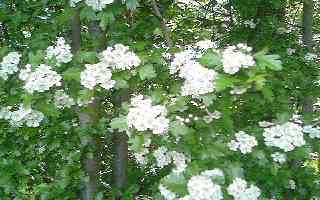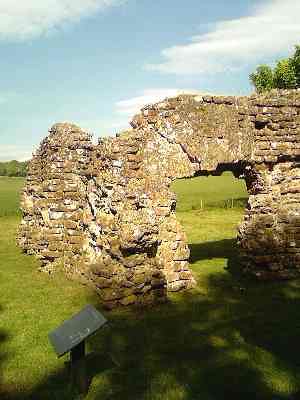Day one, the adventure begins.. well if you count five hours-plus on a train as an adventure. Virgin West Coast line to Carlisle, 20 minutes late; just made the milk-run train to Ravenglas connection, which was handy since there wasn’t another for two hours.
Was navigating that route with a map of the kingdom of Cumbria in about 1100AD, so not entirely clear where I was, and the Sellafield nuclear plant, near the ancient church town of St Bees came as a bit of a surprise. The guesthouse “Muncaster Country” is very pleasant – lovely gardens on to the fields – even boasting wireless internet access, although for five pounds a night I think I’ll pass.
 Took a stroll down to town along the ancient footpath – a profusion of mauve rhododendrons, the May bush in full flower, a couple of sound-asleep mallards beside a very shallow stream. Further down the stream’s course it forms a pond, which was the reservoir for the Roman bathhouse, parts of which still stand to more than 12 feet, at the base of the hill. It was just outside the corner of the Roman fort, the outline of which can be seen. (Most of it hasn’t been excavated.)
Took a stroll down to town along the ancient footpath – a profusion of mauve rhododendrons, the May bush in full flower, a couple of sound-asleep mallards beside a very shallow stream. Further down the stream’s course it forms a pond, which was the reservoir for the Roman bathhouse, parts of which still stand to more than 12 feet, at the base of the hill. It was just outside the corner of the Roman fort, the outline of which can be seen. (Most of it hasn’t been excavated.)

Ravenglass (a Roman port because the confluence of three rivers, the Irt, Esk and Mite, produced a sheltered harbour) it now might be best described as a hamlet – two pubs, a couple of guest houses, and a very fat Jack Russell called Penny, which I could still be patting. The sea shore is a mix of sand and gravel – inter-tidal life consisting of sea lettuce, brown seaweed further down, and very small barnacles, the odd periwinkle, and obviously some sort of pipi out there somewhere, to judge from the broken shells.
The day’s reading, courtesy of the London Library, was Land of the Cumbrians: A Study in British Provincial Origins AD 400-1120, by Charles Phythian-Adams, difficult but interesting. I’m not quite sure why some authors of monographs have to try so hard to make them readable only by experts. Major characters and perhaps even kingdoms (well princedoms) keep being introduced without any explanation; I’d reckon there’s half a dozen people in the world with whom this is envisaging a conversation, yet it wouldn’t add much length or be too much trouble for the experts to skip over.
Anyway, I’ve made sense of most of it. Basically, it is a highly revisionist history, tackling a number of claims that seem to date back a century or in some cases many centuries, but based on flimsy or no evidence. Th basic thesis is that the Norman fiefdoms and royal demense did not necessarily follow earlier cultural, religious or political boundaries. Instead the author argues – chiefly from place-name evidence, with a bit of archaeology thrown in, “Carlisle … until the days of Earl Siward … was probably more or less continously the seat of kings or sub-kings”, but their control only occasionally ran north of the Solway. The coastal region – so open to the Irish Sea, also had pretty much its own, very multicultural history. (p. 165)
After the Romans left, a number of Romano-British power centres continued to function. (An interesting example of the periphery holding when the cente has gone.) Even when the Anglians had taken over there was continuity, so in 685 a praepositus of the civitas of Carlisle was showing off a Roman well or fountain. The old Roman roads still seem to have been the key transport links. (p. 51) Carlisle was also “one of only 10 Roman towns in Britain (partially to preserve its Roman name.
The whole of the vale of Eden was regarded as royal land and the spine of the kingdom of Rheged, The Anglian penetration of the area was piecemeal – not some great invasion,, and visible mostly along “the southern and western litorals of the lakland dome … during the first half of the 7th century”. Many of the settlers may have been invited to provide protection for the locals . The Eden valley, however, and the Solent area remained a British stronghold for centuries. Even many of the Angles may have been “semi-Celtised”. The region remained up until the Normans to a large extent outside the frontier of Latin Christendom.
“For some two centuries after the fall of Rome the region probably ruled itself. For the next three centuries it may have been subject to Bernicia” [the predecessor to Northumbria] but with strong local autonomy. “The customary sovereignty of the region … [had] enduring customary renders like the noutgeld, or judicial strucures like serjeanty, or obligations like endemot. As admittedly diluted society of ‘Britons’ nevertheless sustained surviving elements of its language, its law, its hagiographical traditions a sense of its history, and a continuing identification with areas further north…. only in the later 12th century … would ‘Cumberland’ and ‘Westmorland’ be absorbed finally into a Normanised England, … few people today seem to remember that it was for ong part of a larger British region that overlapped what is now an area of Scotland”. (p. 171)
Northumbrian authority held sway and probably made itself felt in the establishment of a local line of sub-kings descended from Ecgfrith (who had a claim to Rheged) and Iurminburg. In the 10th century Scots influence becomes highly important. “English Cumbria is likely to have been under indirect or direct Scottish rules for some 150 years with one gap of not more than perhaps 25 years by the time the Normans occupied the district.”
On the coast meanwhile Gaelic Norse colonists, probably about the start of that period, purchased land between the Esk and St Bees, weakening what may have been a powerful local lordship.
As you might expect, given the general paucity of sources, there’s not a lot of specifically women’s history covered. When St Cuthbert came along this way – around Tindale – which keeps a British linguistic element that in Welsh is ial (cir on a) “a fertile upland area” – in a now lost area called Raswraget, he passed through some moorland specifically linked to British women, probably summer shielings. Some of the women came down to meet him, carrying a paralysed boy on a litter. “A typical seasonal division of labour seems indicated.” (p. 79)
The most prominent single woman is the beatified Queen Aethelthryth, who despite being married off to Ecgfrith, the overking of Northumbria, remained resolutely celibate and eventually took the veil in 672. His second wife was Iurminburg, who probably had Celtic Church sympathies (as opposed to the Roman church) had close connections with Carlisle. In 685, when her husband died, she went (possibly with her young son) to the already royal nunnery, headed by her sister (or perhaps sister-in-law) for safety. She later took the veil and became abbess there. (p. 61)
Word of the day is dreng – “a serviential-status group out of which lordships might nevertheless be earned. Perhaps what basically marked off this group as inferior to the ‘free’ was that other obligations normally outweighed he expectation to fight.” (p. 147)
Cumbria comes from “territory of the Cymry” (British “fellow-countrymen”). This is, I assume, more or less the same word from which the Welsh political party is named.)

 About
About